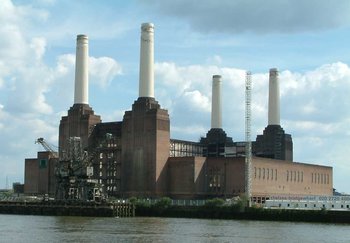Battersea Power Station
|
|
Battersea Power Station, completed in 1939, was the first in a series of very large (for the era) coal-fired electrical generating facilities set up in England as part of the National Grid power distribution system then being introduced. It is a grade II listed building, and is being converted to a large commercial and entertainment complex, as the centrepiece of a project to rejuvenate the surrounding area.
| Contents |
Background
During the 1920s electricity supply was being set up by small companies which built stations dedicated to a single industry or group of factories, and sold off any excess power to the public. However, each company used its own equipment which led to all sorts of small plots where standards differed. One could not generally purchase an electrical applicance and know that it would work where one lived.
Parliament finally decided that the power grid should be a single system under public ownership. This sparked a storm of protest from those who thought that the government should not be involved, and in the end it would be another 30 years before nationalization was completed.
Meanwhile several private power companies reacted to the proposals by forming the London Power Company in 1925. Their plan was to build a smaller number of very large stations and sell the power to anyone who wanted it. Their first power station was planned for the Battersea area on the south bank of the River Thames in London.
Architecture
This sparked off more protests from those who felt the building was too large and would be an eyesore, and those who were worried about the pollution. Ignoring the latter, the company addressed the former by hiring Sir Giles Gilbert Scott, a noted architect and industrial designer (also famous for the design of the red telephone box, of Liverpool Cathedral, and also another London power station Bankside, which now houses the Tate Modern art gallery).
The resulting design is a steel-framed building with brickwork hung from the outside, similar to the skyscrapers being built in the US at the time. Construction started in 1929 and was completed by 1939. The original power station had a single long hall with a chimney at either end. From 1953-55 a second Station B, identical from the outside, was constructed alongside the original, which then became known as Station A. This gave the station its familiar four-chimney layout. Far from being an eyesore, the station has since become one of London's most famous landmarks and is generally loved.
End of operation
In 1975 Station A (now quite out of date) was shut down, with rumors that Station B would soon follow. Intense public pressure mounted to save the buildings, notably Station A's Art Deco interior. In 1980 the station was declared a heritage site, and in 1983 production in Station B ended as well. At that point it was unclear what to do with the building, so a contest was held to look for the best ideas. The winning bid was to construct a theme park inside the grounds (which are huge) and work started on the plan in 1988. The start consisted of cutting huge holes in the roof, through which the machinery was hoisted out to be sold. At that point the project folded: the buildings have remained in this state to this day.
Cultural impact
Big_animals_album_cover.jpg
The Battersea Power Station has also been pictured in many albums by British rock and pop groups. It was featured on the cover for Pink Floyd's 1977 album Animals, with a inflatable pink pig floating high above the station. The inflatable pig seen tethered to the power station "broke loose" from its moorings and reportedly ended up in a garden in south London. These problems led to there being no usable single photo of the pig above the building, and the sleeve is actually a composite image. It can also be seen in the booklet art for The Who's 1973 album Quadrophenia, the album art for The Orb's Adventures Beyond The Ultraworld, and on the back cover of Les Claypool's Frog Brigade's Live Frogs: Set 2, which is a complete cover of Pink Floyd's Animals.
It was also most recently used in 2001 as the background art for the cover of a Petula Clark boxset, Meet Me in Battersea Park.
Battersea Power Station was a setting in Alfred Hitchcock's 1936 film Sabotage. Many years later it was also seen in the "Find The Fish" segment of Monty Python's The Meaning Of Life.
In recent years, the building has occasionally played host to music concerts, and performances by the Cirque du Soleil (in a nearby marquee). In Ian McKellen's film of Shakespeare's Richard III, the derelict power station surreally stands in for Bosworth Field in Richard's final battle scene.
Future
Development company Parkview has started work on a £750m redevelopment of the power station and its site. The plan includes two hotels, a theatre, cinema, flats and a dedicated rail link from Victoria station, as well as rooftop restaurants, incorporating the famous landmark on the banks of the Thames. Battersea Power Station Community Group is campaigning for a new plan for the building to be drawn up.

